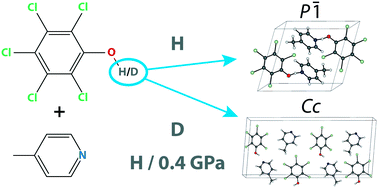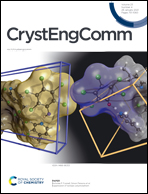Suppression of isotopic polymorphism†
Abstract
The 4-methylpyridine pentachlorophenol co-crystal is known to exhibit the unusual phenomenon of isotopic polymorphism—the hydrogenated form crystallises with triclinic symmetry whereas deuteration of the phenol leads to growth of a monoclinic form instead. We report the use of pressure to overcome the zero point energy difference that leads to the two forms, instead engineering the formation of a hydrogenated, monoclinic co-crystal. This form cannot be obtained via direct compression of the triclinic form, but can be recovered from a diamond anvil cell following pressure-induced growth from solution. Furthermore, with Density Functional Theory calculations, we outline the conditions under which the remaining triclinic–deuterated form might be obtained.

- This article is part of the themed collections: Introducing the CrystEngComm Advisory Board and their research and Supramolecular & Polymorphism


 Please wait while we load your content...
Please wait while we load your content...